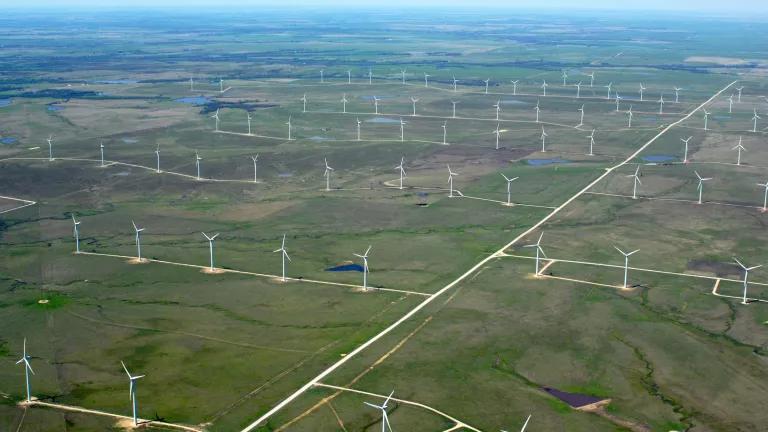A Renewable Energy Revolution in Trump Country?
Americans know which way the energy winds are blowing—and in the heartland, they’re blowing mightily.

A wind farm in Kansas
Something truly noteworthy is taking place in a deep-red swath of the Midwest.
According to a new report from the American Wind Energy Association, four states can now boast that 30 percent or more of their in-state electricity production comes from the wind. That’s an impressive figure, especially given the obstacles that are routinely placed in the way of renewable energy by politicians and administration officials working unabashedly on behalf of the fossil fuel industry.
But when you learn which four states currently lead the wind power pack—Iowa, Kansas, Oklahoma, and South Dakota—it’s not just impressive. It’s incredible.
In these and other GOP strongholds, politicization is giving way to pragmatism. As a result, renewable energy is on the rise. Take Oklahoma, the oil-and-gas-loving state that has brought us not only the anti-environmental EPA Administrator Scott Pruitt but also Senator Snowball himself, Jim Inhofe. Here, the wind industry is either directly or indirectly responsible for up to 9,000 jobs and is currently the largest taxpayer in 14 counties. Last summer, it was announced that Oklahoma would soon be home to a 2,000-megawatt wind farm—the largest in the country and the second-largest in the world.
In 2016, Kansans voted for Donald Trump over Hillary Clinton by a margin of 20 points—predictable in a state that hasn’t voted for a Democratic presidential candidate since 1964. But there, too, renewable wind energy is becoming a powerhouse. Kansas now has the third-highest wind production per capita of all states, with enough generating capacity—more than 5,000 megawatts—to power 1.7 million homes. Its farmers and ranchers receive lease payments totaling up to $15 million to $20 million a year from wind energy companies.
Iowa’s amazing success in this realm is already well documented; the Hawkeye State currently towers above the rest of the nation in its wind energy portfolio, which makes up 36.9 percent of its in-state electricity production. (At 36 percent, Kansas is a close second.) Upstart South Dakota is the newest state to join the 30 Percent Club. Within the next five years, the Mount Rushmore State is expected to triple the size of its nascent yet already booming wind industry, thanks to $450 million in private investment that has been spurred by the state’s generous tax breaks.
But these four states have more in common than their demonstrated enthusiasm for wind. All have Republican governors, Republican-controlled state legislatures, and Republican-dominated congressional delegations. By embracing this particular form of renewable energy, each of them is sending a signal to those who would stand in the way of the renewables revolution and keep America mired in the unsustainable fossil fuel economy. They’re saying to everyone, at both ends of the political spectrum: This is the future—the future of energy production; of permanent and well-paying energy sector jobs; of synergy between public policy and private enterprise; of economic security for farmers, ranchers, and other rural landowners; of cleaner air and climate action.
The Trump administration certainly appears determined to suppress the growing demand for wind and solar. Not only has it proposed slashing by 72 percent the 2019 budget for the Department of Energy’s Office of Energy Efficiency and Renewable Energy, but it has also imposed tariffs on solar component imports, an act that could cripple the domestic solar industry in its infancy.
In his State of the Union address last January, Trump made no mention whatsoever of the progress renewable energy has made all across the country. (Although he did make one wholly embarrassing reference to “beautiful, clean coal.”) The good news is that even in those states where Trump won handily in 2016, and where he continues to receive support, people aren’t buying this cynical line. That’s not to say that wind energy doesn’t face political obstacles in Iowa, Kansas, Oklahoma, and South Dakota. In each of them, fights have recently emerged over the location of wind farms, the structure of tax incentive packages, and other aspects of the industry’s development.
But it’s important to note that these fights are over how, when, and where to build this industry—not whether to build it. That ship, indisputably, has sailed. And it’s being carried along by some powerful, and you might even say unstoppable, headwinds. May they quickly sweep across the rest of the country as well.
This article was originally published on onEarth, which is no longer in publication. onEarth was founded in 1979 as the Amicus Journal, an independent magazine of thought and opinion on the environment. All opinions expressed are those of the authors and do not necessarily reflect the policies or positions of NRDC. This article is available for online republication by news media outlets or nonprofits under these conditions: The writer(s) must be credited with a byline; you must note prominently that the article was originally published by NRDC.org and link to the original; the article cannot be edited (beyond simple things such grammar); you can’t resell the article in any form or grant republishing rights to other outlets; you can’t republish our material wholesale or automatically—you need to select articles individually; you can’t republish the photos or graphics on our site without specific permission; you should drop us a note to let us know when you’ve used one of our articles.


Clean Energy Has Struggled During the Current Economic Crisis—but It’s Strong Enough to Recover
The “Big Tent” of People Who Want Climate Action Just Keeps Getting Bigger
Environmental Triumphs Over Trump